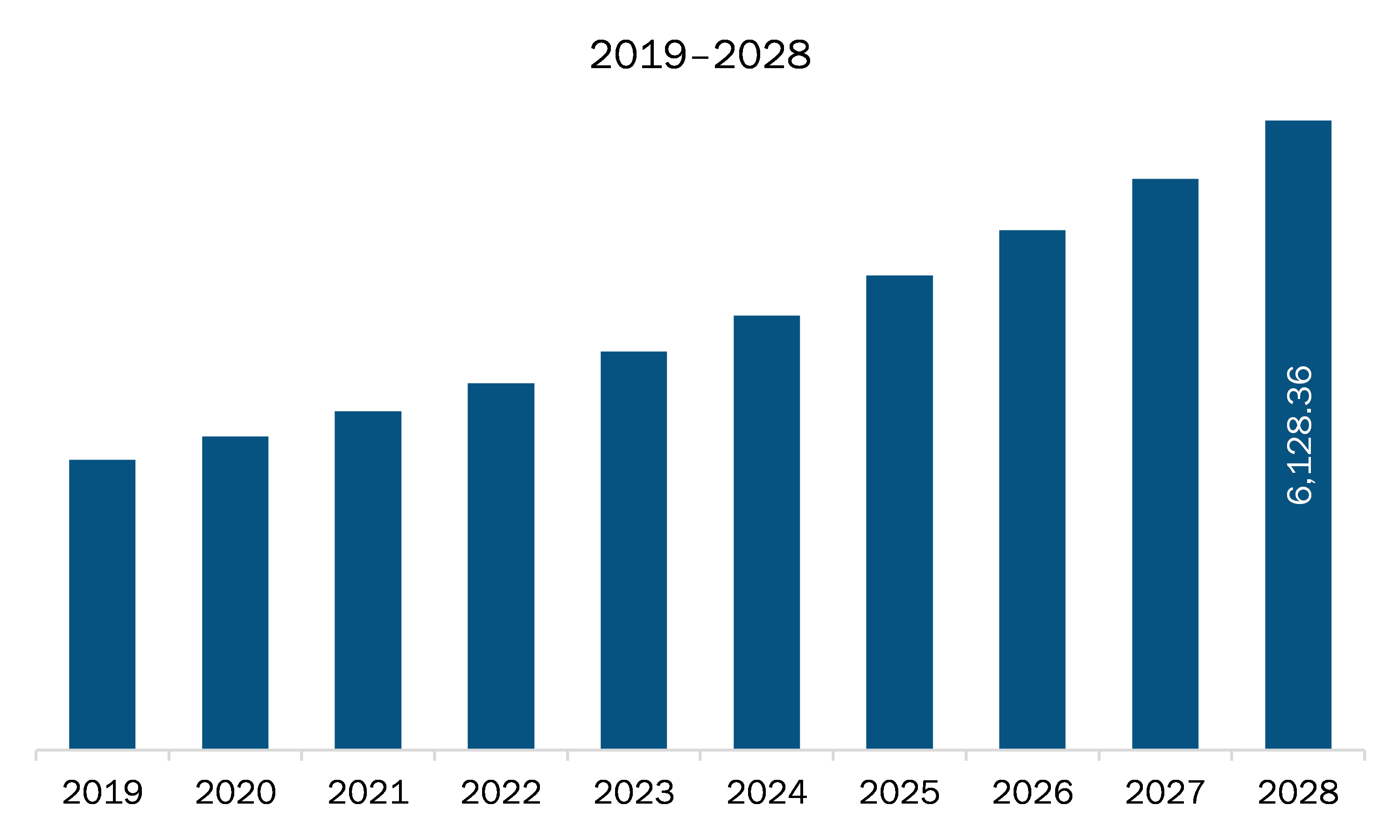The North America radiopharmaceuticals market is expected to grow from US$ 3,296.97 million in 2021 to US$ 6,128.36 million by 2028; it is estimated to grow at a CAGR of 9.3% from 2021 to 2028.
The US, Canada, and Mexico are economies in North America. Felicity of alpha radio immunotherapy in targeted cancer treatment is expected to surge the market growth. The Targeted alpha therapy (TAT) is the latest and evolving technique used for local and systemic cancer treatment. Preclinical research and clinical trials prove that alpha-emitting radionuclides kill targeted cancer cells and do not harm the healthy cells (selective cytotoxicity). 211At, 213Bi, 225Ac, and 227Th are among the alpha-emitting radioisotopes used to label targeting vectors such as monoclonal antibodies; the monoclonal antibodies labeled with α-emitting radionuclides are emerging as an effective radioimmunotherapy. Shorter-range radioisotopes (α particles) are used for treating patients with hematological cancer. Alpha radiations are suitable for killing isolated cancer cells in the vascular and lymphatic systems as well as in regressing tumors by disturbing tumor capillary networks for targeting and killing tumor capillary endothelial cells (ECs). The Radium-223 dichloride alpha therapy is the only approved concept for internal alpha-emitting radioisotope cancer treatment. The decay of radioactive elements after reaching the malignant tissue releases tumor-destroying radiations without causing significant damage to the adjoining healthy tissues. The alpha radiations are much localized, and they penetrate a maximum of 2–10 cell layers. Healthy cells in the surrounding tissue can recover from any damage caused by the radiation to a certain extent themselves. Nuclear imaging uses gamma emitters that have a long lifespan, which allows blood clearance as the tumor increases its uptake of the conjugate over time, so improving contrast. Nuclear imaging agents allow the diagnosis of tumor and organs. In addition, the rise in awareness about alpha radioimmunotherapy and surge in the availability of therapies for cancer treatment procedures are propelling the demand for nuclear imaging. Thus, the preferred use of alpha radioimmunotherapy in the treatment of cancer is fueling the North America radiopharmaceuticals market growth.
In case of COVID-19, North America is highly affected especially the US. The COVID-19 pandemic has significantly impacted the US radiopharmaceutical market. As per the Society of Nuclear Medicine and Molecular Imaging (SNMMI), nearly 80% of respondents saw declines of 50%-75% in non-PET nuclear medicine procedures. In addition, it was also reported that COVID-19 had changed policies for radiopharmaceutical preparations in nuclear medicine (NM) departments by negatively impacting the regular operation of radio pharmacy labs. The COVID-19 has a potential economic impact on most of the sectors, including the oncology procedures. The pandemic has hindered cancer diagnosis and surgeries and is likely to negatively impact the market. The radiopharmaceuticals market in the US is expected to witness modest growth driven by an aging population, increases in health risk factors like poor lifestyle, and the adoption of new technology due to favorable regulatory changes. However, the overall market expansion will be hindered by a saturated installed base of large imaging systems and the consolidation of hospitals. Also, the pandemic has dramatically affected the activities in radio pharmacy laboratories globally. The pandemic affected scheduling criteria, with most staff encouraged to stay at home or observe the social distance. In many radio pharmacy labs, diagnostic imaging tests are quantitatively reduced, and certain imaging centers reduced their test procedures to almost half (18.2%). Thus, the market for radiopharmaceuticals region is expected to witness negative growth for a certain period of time.
With the new features and technologies, vendors can attract new customers and expand their footprints in emerging markets. This factor is likely to drive the North America radiopharmaceuticals market. The North America radiopharmaceuticals market is expected to grow at a good CAGR during the forecast period.

- This FREE sample will include data analysis, ranging from market trends to estimates and forecasts.
North America Radiopharmaceuticals Market Segmentation
North America Radiopharmaceuticals Market – By Type
- Diagnostic Nuclear Medicine
- SPECT
- PET
- Therapeutic Nuclear Medicine
- Alpha Emitters
- Beta Emitters
- Brachytherapy Isotopes
North America Radiopharmaceuticals Market – By Application
- Oncology
- Cardiology
- Neurology
- Others
North America Radiopharmaceuticals Market – By End User
- Hospitals
- Imaging Centers
- Academic and Research Centers
- Others
North America Radiopharmaceuticals Market, by Country
- US
- Canada
- Mexico
North America Radiopharmaceuticals Market -Companies Mentioned
- Advanced Accelerator Applications
- Bayer AG
- Bracco Imaging S.p.A
- Cardinal Health Inc
- Curium
- ECZACIBAŞI MONROL NUCLEAR PRODUCTS CO.
- GENERAL ELECTRIC
- Lantheus Medical Imaging, Inc.
- Nordion
- NTP RADIOISOTOPES
North America Radiopharmaceuticals Report Scope
| Report Attribute | Details |
|---|---|
| Market size in 2021 | US$ 3,296.97 Million |
| Market Size by 2028 | US$ 6,128.36 Million |
| CAGR (2021 - 2028) | 9.3% |
| Historical Data | 2019-2020 |
| Forecast period | 2022-2028 |
| Segments Covered |
By Type
|
| Regions and Countries Covered |
North America
|
| Market leaders and key company profiles |
|
- Historical Analysis (2 Years), Base Year, Forecast (7 Years) with CAGR
- PEST and SWOT Analysis
- Market Size Value / Volume - Regional, Country
- Industry and Competitive Landscape
- Excel Dataset
Recent Reports
Testimonials
Reason to Buy
- Informed Decision-Making
- Understanding Market Dynamics
- Competitive Analysis
- Identifying Emerging Markets
- Customer Insights
- Market Forecasts
- Risk Mitigation
- Boosting Operational Efficiency
- Strategic Planning
- Investment Justification
- Tracking Industry Innovations
- Aligning with Regulatory Trends






















 Get Free Sample For
Get Free Sample For